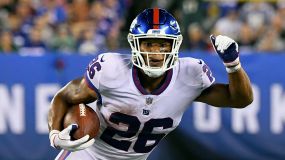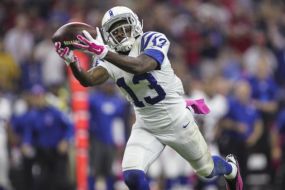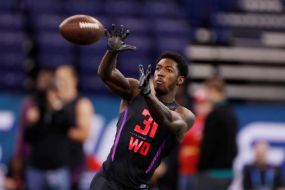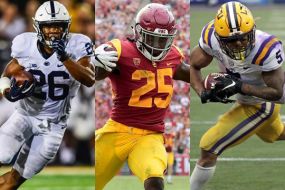Fantasy Finish Line Podcast: Week 4 Preview, Say-Say What?
For many fantasy team managers, the worst thing imaginable happened this past week as Saquon Barkley suffered a high-ankle sprain that could keep him out for most of the regular season. We'll discuss that and other developing situations around injuries on the show this week.
Who are the top performers in the league that are still unowned by most team owners? We'll also identify those targets that you should be picking up or stashing on your bench before it's too late to grab them from the waiver wire!
Can you guess the musical theme for this podcast? Contact us via email with your guess and we'll send a prize out to the first person to guess correctly. Cheers! Feel free to consult This email address is being protected from spambots. You need JavaScript enabled to view it., This email address is being protected from spambots. You need JavaScript enabled to view it. or ask us your lineup questions @drinkfive on Twitter. Best of luck going forward!
Listen to the Fantasy Finish Line, 9/25/2019: Week 4 Preview: Say-Say, What?
Subscribe to our podcast on iTunes to get notifications whenever we release a new episode. We also broadcast the shows live at http://www.mixlr.com/drinkfive on Wednesday nights. Feel free to browse over and join in the discussion in the chat room!
Week 4: Fantasy Injury Impact
For more in-depth analysis and discussion of these injury scenarios, tune in to the Fantasy Finish Line Podcast, Week 4 Preview: Say-Say, What?
QUARTERBACKS
Case Keenum (foot) – Keenum did not practice today, and according to ESPN beat reporter John Keim, he is in a walking boot for precautionary measures. The expectation ‘as of now’ is that he will play but that is clearly questionable. Whether or not Dwayne Haskins (2% owned) ends up making his first NFL start this week, Keenum is banged up and coming off of his worst game of the season against the Bears, who managed 5 forced turnovers including 2 fumbles from Keenum. It’s looking rough in Washington.
RUNNING BACKS
 LeSean McCoy (ankle) & Damien Williams (knee) – Darrel Williams (109-total-yards) led the Chiefs’ backfield in touches Week 3 against the Ravens, but McCoy was still out there and productive (80-total-yards, 38% of the snaps, 2 TDs). The info to know for now is that Darrel Williams (40% owned) is definitely in front of Darwin Thompson (19% owned) on the depth chart, which is why he was a big waiver pickup this week with all of the prolonged injury concerns with Damien Williams (who is still not practicing and doesn’t figure to suit up in Week 4), and that LeSean McCoy tweaked his injured ankle in that game, and didn’t touch the ball in the 4th quarter – he is currently limited in practice. Williams will continue to have an impact.
LeSean McCoy (ankle) & Damien Williams (knee) – Darrel Williams (109-total-yards) led the Chiefs’ backfield in touches Week 3 against the Ravens, but McCoy was still out there and productive (80-total-yards, 38% of the snaps, 2 TDs). The info to know for now is that Darrel Williams (40% owned) is definitely in front of Darwin Thompson (19% owned) on the depth chart, which is why he was a big waiver pickup this week with all of the prolonged injury concerns with Damien Williams (who is still not practicing and doesn’t figure to suit up in Week 4), and that LeSean McCoy tweaked his injured ankle in that game, and didn’t touch the ball in the 4th quarter – he is currently limited in practice. Williams will continue to have an impact.
Devin Singletary (hamstring) – According to the humorously named website ‘Buffalo Rumblings’, Singletary (78% owned) is still not practicing after suffering a hamstring injury in Week 2. There is not much indicating that things will change for the Bills’ backfield – leaving Frank Gore (57% owned) to continue as the unchallenged starter. In Week 3, Gore put up 76 yards on 14 rushes and 1 TD.
Ito Smith (concussion) – Smith’s (15% owned) absence after leaving in Week 3 because of a concussion only helps the underperforming Devonta Freeman. We’re finally able to look at trends, and here we see Freeman’s carries going up from 8 to 11 to 16 from Weeks 1 to 3 and putting up 88-yards on 16 rushes and 7 yards on 3 receptions in the game last week was a good sign. Not explosive, but enough work to be an every-week starter if this pattern continues. This guy needs a TD!
Rashaad Penny (hamstring) – Penny (60% owned) injured his hamstring during the walkthrough before the game last week, but the word from Pete Carroll is that he should be ok to practice on Thursday. With Chris Carson having already lost 3 fumbles this year, it’s possible that Seattle could start to give Penny the majority of the carries but all of the talk from Carroll has continued to back up Carson as the starter so I wouldn’t count on anything changing just yet in that backfield. C. J. Prosise (1% owned) is also a RB on the Seattle Seahawks.
Saquon Barkley (high-ankle sprain) – Oh gosh. Big news for fantasy football team managers, and every year you have one of the top guys go down – this year it’s Saquon. Although he’s getting a second opinion on the ankle, these kinds of sprains don’t fully heal for months. It’s my opinion that we don’t get Barkley back as himself for the remainder of the fantasy season. The interesting thing here is that some other opportunities may arise for fantasy points in New York, either from backup Wayne Gallman (71% owned), or from elsewhere (Kenyan Drake (58% owned), or free agents like Jay Ajayi (2% owned), CJ Anderson (5% owned), and Spencer Ware (0% owned)). Although Gallman was arguably at the top of waiver wire adds this week, I just don’t see the upside. He’s never averaged more than 4.3-yards per rush, and never scored more than 1 TD in a season. I think the Giants must obtain someone else, at least for short yardage.
WIDE RECEIVERS
 T.Y Hilton (quad) – Hilton was already nursing a quad injury when he suited up and played in Week 3 (8 receptions for 65 yards and 1 TD), and he had to leave the game after aggravating the same injury before halftime. He’s not practicing this week and looks to be a game-time decision against the Raiders in Week 4. Not good for the Colts but look at Deon Cain (0% owned) and Parris Campbell (4% owned) to start getting a little more spotlight if Hilton has an extended absence.
T.Y Hilton (quad) – Hilton was already nursing a quad injury when he suited up and played in Week 3 (8 receptions for 65 yards and 1 TD), and he had to leave the game after aggravating the same injury before halftime. He’s not practicing this week and looks to be a game-time decision against the Raiders in Week 4. Not good for the Colts but look at Deon Cain (0% owned) and Parris Campbell (4% owned) to start getting a little more spotlight if Hilton has an extended absence.
Desean Jackson (abdomen) – Already ruled out as of today, Jackson is not ready to get back into the game just yet on this short week (Thursday night game against the Packers). Although most of the experts thought that J.J. Arcega Whiteside (4% owned, 1 catch for 10 yards) would benefit from Jackson being off the field, it turns out that Mack Hollins (1% owned, 3rd year receiver, 4 catches for 62-yards) ended up being the guy in the stat book last weekend.
Julian Edelman (ribs) – After coming off the field in week 3, Edelman was taken for chest X-rays in the locker room, but everything came back negative. Both Edelman and Josh Gordon (hip/finger) should be good to go in a match-up against the Bills this week, but it’s a situation to monitor. In the meantime, Phillip Dorsett (50% owned) is again on the radar with Antonio Brown outta town, and he made the most of his playing time last week with 6 catches for 53 yards and 1 TD. He also rushed twice for 12 yards.
TIGHT ENDS
Vance McDonald (shoulder) – Earlier in the week it looked like McDonald (84% owned) may have suffered a major injury and some were reporting that Nick Vannett was traded to the Steelers from the Seahawks because of those injury concerns. Turns out, though, that it’s Xavier Grimble (calf) that has been put on injured reserve – the Steelers were just looking for another big-bodied blocking tight end to replace Grimble’s production. It’s not 100%, but there’s a good chance that McDonald ends up playing against the Bengals for Monday Night Football.
Rookie Report Special: Rookie Stock Watch after the Combine
Welcome back to the Rookie Report! With the NFL Combine completed, the offseason is in full swing. Trades are happening, vets are being released or retiring, and NFL front offices have got the media spin machine up and running ahead of the start of the league year next week. Despite the flurry of NFL news we’ve been seeing in recent weeks, there is still plenty more news to come before the NFL Draft. Since so much of a rookie's outlook can depend on landing spot and how early they're drafted, it would be premature to rank the rookies for fantasy purposes at this point. That doesn't mean we have nothing to talk about though. We've seen plenty of the top prospects take part in the Senior Bowl, and just about all of them took part in the Combine in some shape or form. This week, I wanted to take a look at which prospects have helped and hurt their stock the most so far this offseason. Let's dive in...
Quarterbacks:
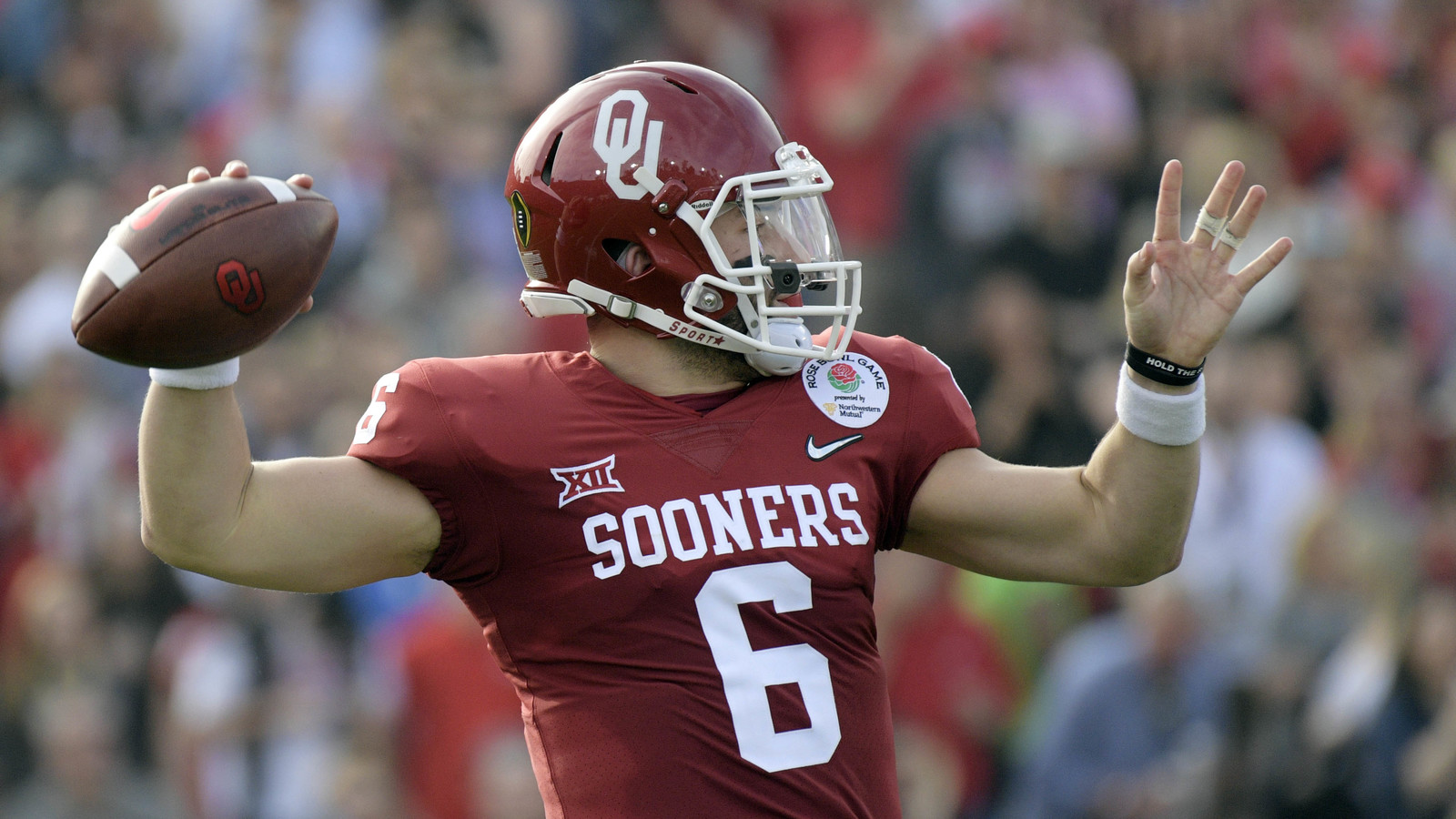 Baker Mayfield, Oklahoma – Stock Up: Mayfield backed up a strong week at the Senior Bowl with another strong week at the Combine. Questions will still abound about his size and his maturity level, but I think he's secured himself as a top-5 pick in the upcoming draft. Mayfield measured a little taller than expected at the Combine, and threw the ball well in drills and demonstrated solid arm strength. The film on Mayfield is solid, but there have been several questions about him that the film doesn't answer. He has at least started answering some of those questions based on the feedback being put out by some scouts and personnel people in Indy.
Baker Mayfield, Oklahoma – Stock Up: Mayfield backed up a strong week at the Senior Bowl with another strong week at the Combine. Questions will still abound about his size and his maturity level, but I think he's secured himself as a top-5 pick in the upcoming draft. Mayfield measured a little taller than expected at the Combine, and threw the ball well in drills and demonstrated solid arm strength. The film on Mayfield is solid, but there have been several questions about him that the film doesn't answer. He has at least started answering some of those questions based on the feedback being put out by some scouts and personnel people in Indy.
Josh Allen, Wyoming - Stock Down: Josh Allen has been talked about as a potential top overall pick in the draft for weeks now, but with the scrutiny that comes with scouting season, and the Senior Bowl and Combine weeks, more of the warts of his game have been showing through. Yes, he has a big arm and ran well in the 40-yard dash, but his inaccuracy has been on full display, often misfiring badly when he does miss a throw. People see the athleticism and the cannon and want to project him to be Andrew Luck or Carson Wentz, but more of the scouts are starting to see the possibility that he ends up closer to Kyle Boller. You'll hear about Allen in the top-5 a bunch between now and draft day, but don't be surprised if he slips out of the top-10.
Sam Darnold, USC – Stock Down: Darnold elected not to do any throwing at the Combine but elected to do the athletic testing, which he showed very poorly in. Sam tested in the 22nd percentile of SPARQ scores. His lack of mobility is a little troubling for a guy who can be kind of a gunslinger at times. If he can't escape the pocket, is he going to throw into to trouble when pressured? Darnold is still likely to be a first-round pick in the Draft and can still impress at USC's pro day, but as a guy who is being projected as a possible #1 overall pick, the Combine didn't do him any favors.
Running Backs:
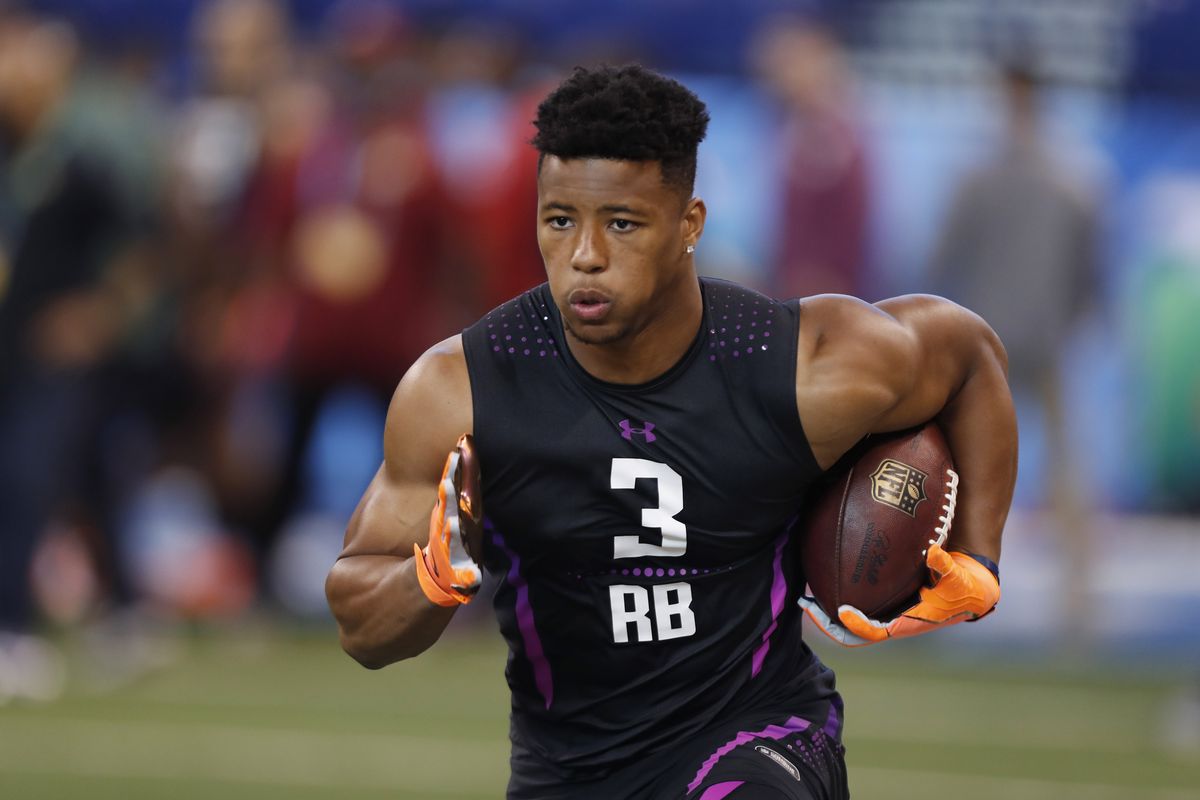 Saquon Barkley, Penn State – Stock Up: Barkley was already pretty much a consensus for the 1.01 pick in rookie drafts before the Combine, but his performance in Indy should have converted any doubters. Barkley weighed in at 233 pounds, and ran a blistering 4.40 40-yard dash and posted the best vertical jump of any RB at the Combine (41”). To have that kind of explosion and athleticism at Barkley's size is special, and the work he put on film at Penn State already had him as the best back in this class. If you have the first pick in a rookie draft, you'd be a fool not to take Saquon. If you really don't want him, there is bound to be someone in your league who does and will pay a king's ransom for him.
Saquon Barkley, Penn State – Stock Up: Barkley was already pretty much a consensus for the 1.01 pick in rookie drafts before the Combine, but his performance in Indy should have converted any doubters. Barkley weighed in at 233 pounds, and ran a blistering 4.40 40-yard dash and posted the best vertical jump of any RB at the Combine (41”). To have that kind of explosion and athleticism at Barkley's size is special, and the work he put on film at Penn State already had him as the best back in this class. If you have the first pick in a rookie draft, you'd be a fool not to take Saquon. If you really don't want him, there is bound to be someone in your league who does and will pay a king's ransom for him.
Nick Chubb, Georgia – Stock Up: Chubb was overshadowed by the incredible numbers Barkley put up in Indy, but he had an impressive week himself. Chubb ran faster than expected at 4.52 in the 40 and showed more explosion than expected with a 38.5”vertical jump. He also showed his strength by matching the impressive 29 bench press reps that Barkley put up. While Saquon and Derrius Guice are widely considered to be the top 2 running backs in this class, there are a handful of backs behind them that are grouped very closely together, and Chubb did a great job of helping himself stand out among that group. He should go in the top half of the first round in most rookie drafts.
Ronald Jones II, USC – Stock Down: Jones saw his stock start to slip even before the combine as scouts started to point out his lack of prowess as a between-the-tackles runner, and his lack of receiving production in college. He also seemed undersized to be an every-down back in the NFL. He could have really helped himself with a strong showing at the Combine, but it was not to be. He weighed in at just 205 pounds. Only 7% of all running backs 5'11” or taller at the Combine in the past 15 years have weighed 205 or less (per @GrahamBarfield), and the list doesn't include much success outside of Jamaal Charles. Jones could have really helped himself with a fast 40 time, but he pulled up with a hamstring issue during his run and ran a 4.66. He can still help himself by running a quality time at his pro day, but as of now, it's hard not to view Jones as being towards the tail end of the top-10 rookie backs.
Bo Scarbrough, Alabama – Stock Up: There hasn't been a ton of buzz around Scarbrough so far this offseason, but he changed that at the Combine. Bo has mostly been viewed by the scouting community as a physical grinder who wasn't overly athletic, but he changed that perception in a big way last week. Bo ran a 4.52 40-yard dash, and also stunned with a 40”vertical (2nd only to Saquon) and a 10'9” broad jump (best among RBs). He also was better than expected in receiving drills in Indy. He went from being a guy that not many people were excited about to someone who may wind up a top-8 RB in this class.
Kamryn Pettway, Auburn – Stock Down: Like Scarbrough, Pettway also came into Indianapolis with a reputation of being a physical runner, but his measurable numbers didn't do him any favors. He weighed in at the same size as Saquon Barkley, but he ran just 4.75 in the 40-yard dash. That's basically fullback speed. He may wind up undrafted despite posting a 1,200-yard season in just 10 games in the bruising SEC a couple years ago. He shouldn't be on your fantasy radar.
Royce Freeman, Oregon – Stock Up: Freeman has long been viewed as one of the better backs in this class, and he tested better at the Combine than expected. Freeman ran a 4.55 40-yard dash and displayed some agility with a respectable 6.90 in the 3-cone drill. He also looked smoother than expected in receiving drills. Landing spot will be a big deal for Freeman, but if the fit is right, he could push for a spot in the top 5 or 6 backs in this class.
Chase Edmonds, Fordham – Stock Up: Edmonds probably isn't a guy that's been on your radar, but he posted some eye-opening numbers at the Combine that could make him a sneaky mid-round rookie pick in dynasty leagues. Edmonds stands just 5'9” and weighs 205, but he managed to bench press 225 lbs 19 times. He also had the best time in the 3-cone drill of all of the backs that participated and posted a respectable 4.55 40-yard dash. Edmonds will also get a boost from his versatility, as he worked out at wide receiver as well as running back. His skill set is reminiscent of Dion Lewis, and it wouldn't surprise me if he wound up in New England as a replacement for the free agent back on the Pats’ roster.
Wide Receivers:
 DJ Moore, Maryland – Stock Up: Moore came into the Combine with some question marks about his size, and he actually measured in a little bigger than expected at 6’0” and 210 pounds. Even more importantly for DJ, he tested very well athletically and aced all of the on-field drills as well. His 4.42 40-yard dash was among the fastest WR times there, and he showed some explosion with a 39.5” vertical and an 11’ broad jump. ESPN’s Mel Kiper Jr. called him the most impressive WR in Indy. He should have at least cemented himself as a top-3 WR in this class.
DJ Moore, Maryland – Stock Up: Moore came into the Combine with some question marks about his size, and he actually measured in a little bigger than expected at 6’0” and 210 pounds. Even more importantly for DJ, he tested very well athletically and aced all of the on-field drills as well. His 4.42 40-yard dash was among the fastest WR times there, and he showed some explosion with a 39.5” vertical and an 11’ broad jump. ESPN’s Mel Kiper Jr. called him the most impressive WR in Indy. He should have at least cemented himself as a top-3 WR in this class.
Auden Tate, Florida State – Stock Down: Tate is a big, physical WR with strong hands, but his athleticism at the Combine was a disappointment. Scouts were disappointed when fellow Seminole Kelvin Benjamin ran a 4.61 40-yard dash at the Combine a few years ago, and Tate was even slower than that, registering a 4.68. He also had a less than impressive 9’4” broad jump. He’ll still be a red zone weapon at the NFL level and will likely be drafted in your rookie drafts as a top-10 WR option, but his lack of athleticism certainly hurts what his pro ceiling may look like.
DJ Chark, LSU – Stock Up: Chark put on a show in Indianapolis, posting the best 40 time among the WRs (4.34), and also tallying a 40” vertical and 10’9” in the broad jump. Chark was a popular sleeper pick among some in the fantasy community, but he won’t be as much of a secret anymore. He may get a benefit out of coming from LSU, a school that has a reputation for their receivers ascending when they get to the NFL. The list of LSU receivers since the start of the Les Miles era to post more receiving yards in a season as a pro than they did in any college season includes Dwayne Bowe, Brandon LaFell, Rueben Randle, and Odell Beckham Jr. That list doesn’t even include Jarvis Landry, who has put up 400 receptions in his first 4 seasons in the NFL. Although Les Miles is gone from LSU, Chark’s career there started with him still there. Chark could be a top-5 WR in this class.
Calvin Ridley, Alabama – Stock Down: Ridley has been expected to be the first wide receiver taken in the NFL Draft pretty much since the Super Bowl ended, but that may be changing as the offseason process goes on. He tested very poorly in Indianapolis, He came in a little lighter than expected at 189 pounds, and while his 4.43 40-yard dash was strong, he tested so poorly in the jumping and agility drills that his SPARQ score puts him in just the 7th percentile of athletes, worse than any other WR at the Combine. His status as the WR1 in this class is in serious doubt based on what he did in Indy.
Deon Cain, Clemson – Stock Up: Cain has been a little bit of a polarizing prospect in some scouting circles. A lot of people look at Cain as just the next in the line of Clemson WRs to go to the NFL, following Sammy Watkins, Martavis Bryant, DeAndre Hopkins, and Mike Williams (well, the jury’s still out on Williams). It’s not hard to see why. When a program has a track record like Clemson does, you see the size, production, and athleticism and it’s easy to project Cain as the next in line, but some scouts that have started breaking down Cain’s film are finding more holes in his game than those that preceded him. It’s because of those doubters that Cain actually helped himself in Indy. He didn’t blow the doors off the athletic testing (was just a 34th percentile SPARQ athlete despite a 4.43 40-yard dash), but he looked more polished as a receiver in the drills than a lot of scouts had been seeing on film. He drew praise from former star wide receiver Steve Smith, who spoke highly of the way he caught the ball and how smooth he looked in and out of breaks in the Combine drills. I think he helped himself enough that he should be a top-10 WR in this class.
Tavares Martin, Washington State – Stock Down: Martin was already looking like a 3rd-day pick due to off-field issues, but his Combine numbers confirmed that he’ll be an undrafted free agent. He was expected to push for a sub-4.5 40-yard dash but instead clocked in at a terrible 4.80. He also registered a less than impressive 31.5” vertical jump. Martin was supposed to be a troubled player with upside due to his athleticism. If he doesn’t have that athleticism, there isn’t really a place for him in the NFL.
Tight Ends:
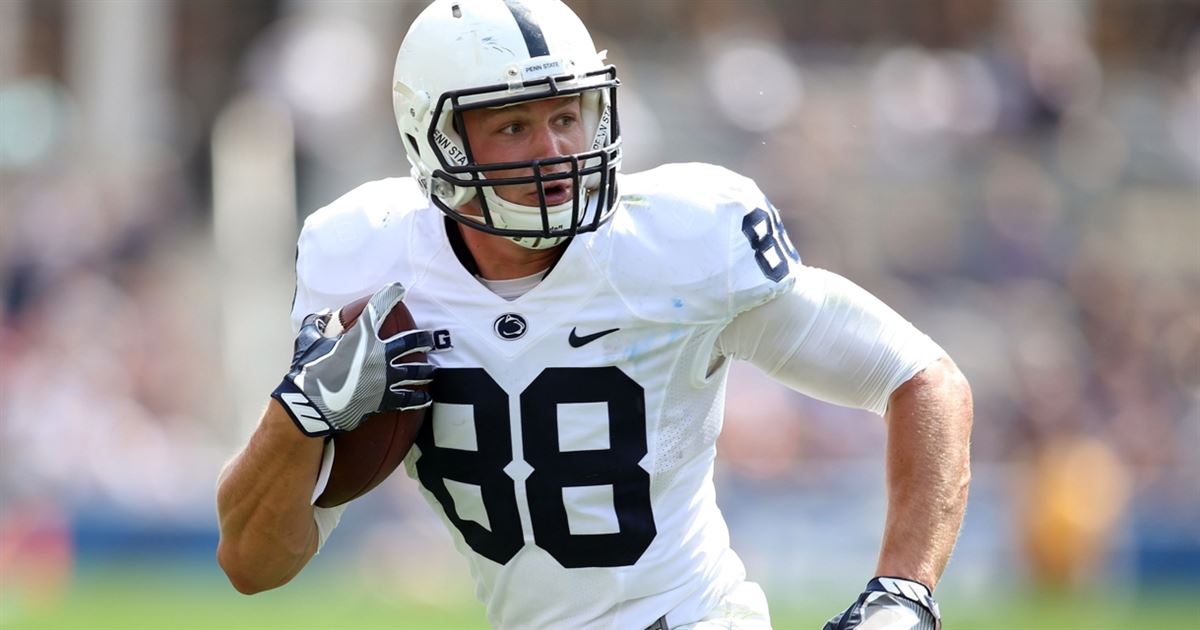 Mike Gesicki, Penn State – Stock Up: While Saquon Barkley stole the show in Indy, his college teammate Gesicki may have been more impressive. Gesicki measured in at an imposing 6’5” and 247 pounds, and he performed historically well in the athletic testing, finishing in the 99th percentile in SPARQ scores. Only Vernon Davis and Dustin Keller have ever tested better at the Combine at the tight end position. South Dakota State’s Dallas Goedert had been getting some traction as the top fantasy tight end in this class, but as Goedert sat out most of the Combine with a hamstring injury, Gesicki took advantage. The Penn State product has already shown that he can be a red zone threat and can make tough catches, but his testing numbers will push him into the conversation for the TE1 in this class.
Mike Gesicki, Penn State – Stock Up: While Saquon Barkley stole the show in Indy, his college teammate Gesicki may have been more impressive. Gesicki measured in at an imposing 6’5” and 247 pounds, and he performed historically well in the athletic testing, finishing in the 99th percentile in SPARQ scores. Only Vernon Davis and Dustin Keller have ever tested better at the Combine at the tight end position. South Dakota State’s Dallas Goedert had been getting some traction as the top fantasy tight end in this class, but as Goedert sat out most of the Combine with a hamstring injury, Gesicki took advantage. The Penn State product has already shown that he can be a red zone threat and can make tough catches, but his testing numbers will push him into the conversation for the TE1 in this class.
Troy Fumagalli, Wisconsin – Stock Down: Fumagalli wasn’t considered to be on the same level as Gesicki, Dallas Goedert, Mark Andrews and Hayden Hurst as a prospect before the Combine, but a strong showing could have really helped his stock. Instead, he posted the fewest bench reps for a tight end (14) and didn’t participate in any other drills. He’ll have a chance to improve how he’s viewed at Wisconsin’s pro day, but he’s got a tough act to follow after many of the top tight ends impressed in Indy. Fumagalli is at best the TE5 of this class right now.
Jaylen Samuels, NC State – Stock Up: Samuels is listed here because he tested with the tight ends in Indianapolis, but his best case scenario is that he will land with a creative coach and be used as a Swiss army knife, splitting time between TE, RB, WR, and H-Back. He’s undersized to play tight end, standing just 5’11”, but he performed well in the athletic testing. He matched Mike Gesicki’s 4.54 40-yard dash and managed to throw up 18 bench reps and a 10’1” broad jump. Samuels looks like he can be an x-factor kind of player in today’s NFL if he lands in the right spot. He could be a sneaky 2nd or 3rd round pick in rookie drafts if the landing spot is a good one.
That's all I've got for now. I'll be back after free agency is a little more settled to talk about ideal landing spots for some of the top rookies ahead of the draft. Things can still change for some of these rookies between now and draft day, but it doesn't hurt to take stock of where they are now. If you have any thoughts or feedback on the info above, don't be a stranger. Reach out on Twitter to let me know (@Shawn_Foss). Otherwise, sit back and enjoy one of the wildest NFL offseasons we’ve seen in years.
Rookie Report Special: Ideal Landing Spots for the Incoming RBs
Welcome back to the Rookie Report! In case you didn't know it, the NFL Draft is almost upon us. We can finally put all of the mock drafts and misdirection by NFL front offices behind us over the next couple days. We will be able to quit guessing who is going where and start assessing how the new pieces fit with their new teams, but we're not quite there yet. So, I wanted to take a stab at picking my favorite landing spots for each of the top backs in the draft before it's too late. Mind you, these landing spots ARE NOT predictions for where the players will be drafted. They're merely my thoughts on what the best landing spots are for all of the backs to maximize scheme fit, career development, and fantasy upside. One other quick note: view this list as a complete picture rather than just looking at each player individually. For example, it's possible you think the Colts' RB job is the best available spot, and therefore it could be the best fit for 3 or 4 of the backs on the list. I'm only listing one back for each spot, so if I think the best fit in Indy is Nick Chubb, that means the starting job in Indy is crossed off the list for everyone else. With that in mind, let's dive into my favorite landing spots for the top RBs in the 2018 draft:
(Player, College - Favorite Landing Spot)
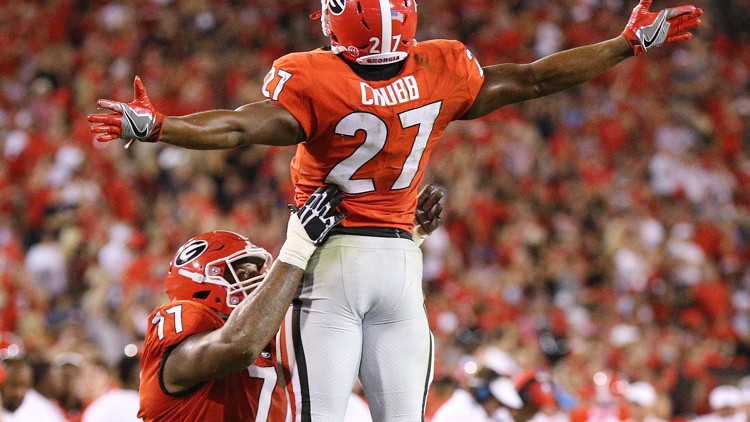
Saquon Barkley, Penn State - Tampa Bay Buccaneers: The Bucs would be ecstatic if Barkley managed to fall to them at pick 7. That's extremely unlikely to happen with the Browns, Giants, Colts and Jets all picking ahead of them. Despite that, I think Tampa is the place where Barkley would shine the brightest. Head coach Dirk Koetter runs a vertical passing scheme and has plenty of deep threat weapons in Mike Evans, DeSean Jackson and OJ Howard. The deep passing threat will open up plenty of room for Barkley to operate both as a runner and a receiver. Despite his 233-pound frame and the 29 bench press reps he put up at the combine, Barkley does his best work in space rather than banging between the tackles. He'd have plenty of space to operate in Tampa's system. He also has the prerequisite pass protection skills necessary for a running back in a scheme like this one. The last time Koetter had a fully healthy three-down back was 2015, when Doug Martin totaled nearly 1,700 scrimmage yards and 7 TDs. Saquon is a much better receiver than Martin. He'd have legitimate top-5 RB upside in year 1 if he ended up in Tampa.
Derrius Guice, LSU - Cleveland Browns: Like Nick Chubb, Guice wasn't used a lot as a receiver in college, so there are some questions about whether or not he can be a true three-down back in the NFL. I think he can be, but like the Colts the Browns have a built-in answer to those questions in Duke Johnson. Guice is a physical runner who could very well wind up being the best back in this class, and Cleveland won't have to take him in the top four picks of the draft to get him.
Sony Michel, Georgia - Detroit Lions: The run game has been a problem in Detroit for a long time. They've had just one back break 1,000 rushing yards in a season since 2004 (Reggie Bush in 2013 with 1,006 yards). It's time to fix the problem, and Michel may be the way to do it. Part of the issue is that the Lions haven't had a true three-down back since maybe Kevin Jones (the back who broke 1,000 yards in '04). They've utilized a pass-first offense for most of the time that Matt Stafford has been the QB, so they've focused on getting running backs who are adept receivers. They've had guys like Reggie Bush, and Ameer Abdullah, and Theo Riddick, and Jahvid Best. The thing about Michel is that he is an adept receiver (one of the best in this class), but also an excellent runner, even between the tackles despite a slight frame for a feature back. Anyone who watched him run against Alabama in the National Championship could regale you with stories of his skill as an inside runner. He could have just the right combination of skills to finally give the Lions the feature back they've been seeking for over a decade.
Rashaad Penny, San Diego State - Denver Broncos: Denver is in need of a feature back, and Penny certainly checks most of the boxes you look for. He's big enough, fast enough, and a skilled receiver that can challenge the defense downfield. Denver was long known for the zone blocking scheme in the run game from the Mike Shanahan and Gary Kubiak days, but they have switched to a gap blocking scheme in more recent years, and this scheme is a much better fit for Penny. The one area of his game that could trip Penny up is his pass protection. If he struggles with this early on, it could keep him off the field. If he is able to improve that part of his game quickly, he could be a big-time producer in year one in Denver.
Ronald Jones, USC - New York Jets: Jones has the speed to be the home run threat the Jets currently lack at RB. We know by now that Isaiah Crowell is no more than just an average starter, and Bilal Powell has failed for years to win the featured role. RoJo is a dangerous runner who can put pressure on the edges of the defense to contain him. One question with Jones is his ability as a receiver. He wasn't asked to catch the ball much at USC, so it remains to be seen how good his skill set as a receiver is. If he shows skill as a pass catcher early on, his upside could be huge.
 Royce Freeman, Oregon - Washington Redskins: At the very least, Washington needs an upgrade to their early down running game, and Freeman would provide an upgrade over Samaje Perine and Rob Kelley. Washington loves what Chris Thompson brings as a 3rd-down back, so Freeman would likely start out with just early-down work, but he catches the ball well enough to eventually establish himself as the every down guy. He'd have monster upside in year one if he landed in Washington and something happened to Thompson.
Royce Freeman, Oregon - Washington Redskins: At the very least, Washington needs an upgrade to their early down running game, and Freeman would provide an upgrade over Samaje Perine and Rob Kelley. Washington loves what Chris Thompson brings as a 3rd-down back, so Freeman would likely start out with just early-down work, but he catches the ball well enough to eventually establish himself as the every down guy. He'd have monster upside in year one if he landed in Washington and something happened to Thompson.
Bo Scarbrough, Alabama - Carolina Panthers: Christian McCaffrey's performance last year made it clear that it would be an uphill battle for him to ever become a workhorse back in the NFL. He averaged just 3.7 yards per carry while splitting time with Jonathan Stewart. He needs to be complemented by a power runner. The Panthers spent the 8th overall pick in the draft last year on CMC, so there is no way they would invest the kind of draft capital it would require to land a Guice, Chubb, or even a Royce Freeman to find that power back. Enter Bo Scarbrough. Bo is viewed as a one-dimensional sledgehammer of a runner, but he surprised in a big way with his athletic testing at the combine, showing explosion with a 40" vertical and 10'9" broad jump. Bo is exactly the type of player the Panthers need, and they can get him at a price that makes sense for them.
Kerryon Johnson, Auburn - Miami Dolphins: Johnson's skill as a physical runner isn't that far behind that of Nick Chubb and Derrius Guice. Kenyan Drake doesn't profile as a lead back at his size, and Frank Gore likely has just one more NFL season left in him. Gore would be a great mentor to help Johnson learn the nuance of playing the RB position in the NFL, and Drake and Kerryon would make a formidable tandem by late in 2018 or the start of the 2019 season.
Kalen Ballage, Arizona State - San Francisco 49ers: Ballage is one of the most unique prospects in this class. He has the size, speed and strength to be a special runner, but he really struggles with vision and patience, and doesn't always run with the power that he should. He's also one of the best receiving backs in this class. The 49ers are the team I think is best suited to take advantage of his skills. They don't have a back of Ballage's size that they can use as a goal-line and short yardage back, and Ballage is good enough as a receiver for the 49ers to use him in those spots and still be creative and unpredictable. If he ever develops as a runner, he also might be able to unseat Jerick McKinnon as the starter down the road.
Nyheim Hines, NC State - Philadelphia Eagles: It looks like Darren Sproles will be calling it a career, and even if he isn't, he's no longer under contract with the Eagles. The Eagles have an interesting group of RBs with Jay Ajayi, Corey Clement and Wendell Smallwood, but none of those guys have the game-breaking speed that Hines does. Hines isn't going to step in as a major part of the offense anywhere as a rookie, but the Eagles have innovative enough coaches to find ways to get his speed involved, and his role will grow if he has early success.
John Kelly, Tennessee - New York Giants: Most NYG fans are expecting the team to land Saquon Barkley with the second pick, but if you read my QB landing spot piece prior to this, you know I think Josh Rosen should be the pick there. I really like Kelly as a RB alternative for the Giants. Kelly's a violent runner with agility, and he's also an adept receiver who excels in the screen game. He's also sound in pass protection, which is important since both Eli Manning and Josh Rosen aren't very mobile. He could stand to be a little more explosive, but I think the team that lands Kelly will be pleasantly surprised.
Mark Walton, Miami (FL) - Arizona Cardinals: Walton was used as a feature back in college at Miami, but that will never be his role in the NFL. He's much more likely to be utilized as a 3rd-down back at the NFL level. I like Arizona as a landing spot because he'll be able to see the field a bit spelling David Johnson early on, and he won't have the pressure of being a key cog in the offense before he's ready. He'd also benefit a lot from having Johnson around to learn from. Walton has some upside, but he's more likely to realize his potential if he's not thrust into a big role right away.
Justin Jackson, Northwestern - Pittsburgh Steelers: Jackson would be a fantastic choice as Le'Veon Bell insurance. Bell and the Steelers still haven't hammered out a long-term extension, and with his current salary and asking price, the Steelers may choose to move on from Bell after the 2018 season. Jackson is one of the most underrated backs in this class. He won't cost too high of a pick for Pittsburgh, but has a chance to be a feature back with the playing style of Jamaal Charles. Jackson has shown that he can handle the rigors of a workhorse role despite not being a bigger back. He was an ultra-productive 4-year starter at Northwestern, tallying 1,388 scrimmage yards as a freshman, and at least 1,500 in each of his 3 other seasons. He will surprise if he gets the opportunity.
Akrum Wadley, Iowa - Buffalo Bills: The Bills already have LeSean McCoy and Chris Ivory, but Wadley would be a different style player than either of those guys. The Bills may be playing catch-up in the second half of games quite a bit this season, and Wadley would be a better option to spell Shady McCoy in those situations due to his receiving ability. He would also be a good complementary back to Ivory if anything happened to McCoy. Shady will be turning 30 this upcoming season and has just 2 years left on his current deal, so there is more upside for Wadley's role to grow once McCoy is gone.
Chase Edmonds, Fordham - New England Patriots: Edmonds might be able to step in and serve as the Dion Lewis replacement pretty early on in his career. I don't think he'd play as big a role this year as Lewis did last season, but he excels in some of the same areas. Edmonds isn't quite as elusive as Lewis, but he's still a shifty undersized back who can be a dangerous receiver out of the backfield. No team does a better job finding bargain RBs than the Patriots, and Edmonds would fit that mold as a day 3 draft pick. I'd expect Rex Burkhead to be the most productive Patriot running back this season, but Edmonds could certainly carve out a useful role that could help fantasy teams.
Chris Warren, Texas - Houston Texans: It's been rumored that Donta' Foreman won't be healthy to start the year and may have to open the season on the PUP list. If that's the case, Warren could be a valuable complement to Lamar Miller during the early part of the season. Warren is a very different player than his dad was (former Seahawks' back of the same name). He runs with effortless power and will bulldoze defenders in the open field. He converted to tight end late last season, but that was more because of his prowess as a blocker than receiving skill. I think his best position in the NFL will be running back. There are questions about his vision and acceleration, but his 20-yard shuttle and 3-cone drills at the combine were impressive even if he were 20-30 pounds lighter. If Warren lands with Houston and impresses while Foreman is out, it might be hard for the coaching staff to make him step aside once Foreman returns.
That's all I've got on the running back class until after the draft. If any of the players above do land on the team I've matched them with, that will likely be a good thing for both the player and the team. I did try to at least impart a little bit of knowledge about what type of back each player is. If you disagree with anything written above, don't hesitate to reach out via twitter and let me know (@Shawn_Foss). I'm always up for a spirited debate. In the meantime, keep an eye out for my WR and TE landing spot articles that should be posted Thursday afternoon. Enjoy the draft!
Recent Articles
-
NFL Confidence Pool Picks & Strategy 2024 - Week 18
 To say this has been a year of uncertainty is an understatement. So many injuries, coaching changes, player issues shaped…in Fantasy Football / NFL
To say this has been a year of uncertainty is an understatement. So many injuries, coaching changes, player issues shaped…in Fantasy Football / NFL -
NFL Confidence Pool Picks & Strategy 2024 - Week 17
 Christmas is indeed the time of giving. And this year, the NFL is giving us a double-header on Christmas Day…in Fantasy Football / NFL
Christmas is indeed the time of giving. And this year, the NFL is giving us a double-header on Christmas Day…in Fantasy Football / NFL -
NFL Confidence Pool Picks & Strategy 2024 - Week 16
 Normally, being just a few weeks away from the end of the season, playoff positions are solidified and we need…in Fantasy Football / NFL
Normally, being just a few weeks away from the end of the season, playoff positions are solidified and we need…in Fantasy Football / NFL -
NFL Confidence Pool Picks & Strategy 2024 - Week 15
 Finally! They’re done! We are heading into week 15 and FINALLY we are done with bye weeks! 16 games a…in Fantasy Football / NFL
Finally! They’re done! We are heading into week 15 and FINALLY we are done with bye weeks! 16 games a…in Fantasy Football / NFL
 Please wait...
Please wait...- Home
- drinkfive Podcasts
- saquon barkley
